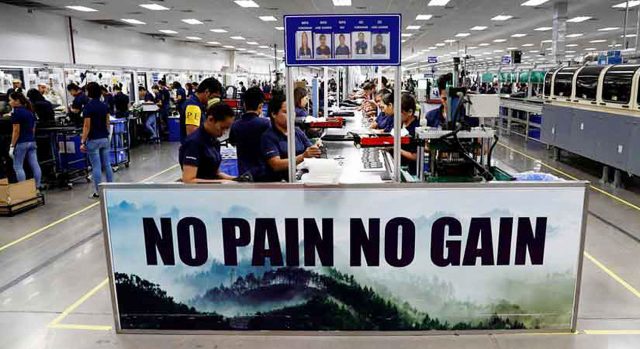Factory output up 5 months in a row

Bernadette Therese M. Gadon
INDUSTRIAL PRODUCTION rose for a fi
fth straight month in August, as many
fi
rms that produce essential goods continued to operate despite the two-week strict
lockdown, the Philippine Statistics Au
thority (PSA) said on Thursday.
Preliminary results of the PSA’s latest Monthly Integrated Survey of Selected Industries showed the volume of production index (VoPI) jumping 534.6% year on year in August. This was slightly lower than the revised annual rate of 539.7% in July, but still a signi
fi
cant turnaround from the 82.2% contraction in August last year.
Similarly, the value of production index (VaPI), a similar composite indicator in the survey, logged in an annual 523.3%. This was slower than the previous month’s 528.7% growth rate, but a reversal of the 83.1% decline last year.
The August reading for VoPI and VaPI marked the
fi
fth straight month of growth in manufacturing output.
For the year, factory output expansion averaged 61.6% and 53.4% in terms of VoPI and VaPI, respectively.
The PSA noted growth in the VoPI in 15 out of 22 industry divisions in August led by coke and refined petroleum products (3,800.9%); fabricated metal products, except machinery and equipment (194.2%); wood, bamboo, cane, rattan articles, and related products (94%).
In contrast, IHS Markit’s Philippines Manufacturing Purchasing Managers’ Index (PMI) declined to a 15-month low in August at 46.4, ending two straight months of growth as factories were forced to close due to a two-week enhanced community quarantine in Metro Manila. However, the country’s PMI rebounded to a six-month high in September at 50.9 following the
relaxation of these restrictions. A PMI
reading above 50 indicates improvement in business conditions from the preceding month.
While the VoPI and the PMI both seek to measure performance of the manufacturing sector, they differ mostly in terms of methodology used. The VoPI looks at the percentage change in production volumes in a particular period relative to a base period while the PMI indicates whether the proportion of respondents that reported an increase outweighs those that reported a decrease as regards indicators like output, new orders, inventory, employment, input and selling prices, as well as sentiment over the following 12 months.
The capacity utilization of these factories averaged 66.1% in August, slightly down from 66.8% the previous month. Of the 22 sectors, 19 averaged a capacity utilization rate of at least 50%.
Leading the sectors with the highest utilization rates were furniture (83.1%), tobacco products (81.6%), and other non-metallic mineral products (79.3%).
Economists interviewed by
BusinessWorld
mainly attributed the sustained growth to the loosened quarantine restrictions, but cited other factors that influenced the August print.
“Those sectors which posted an increase in August mostly belonged to the production of essential goods… Despite the lockdown, these industries still continued operations to meet growing consumer demand,” De La Salle University (DLSU) economist Mitzie Irene P. Conchada said in an e-mail.
In particular, Ms. Conchada cited the increases seen in food products (volume growth of 10.8% in August from 9.2% in July), fabricated metal products (194.2% from 121.1%), and furniture (50.6% from 8.2%), among others.
In a separate e-mail, UnionBank of the Philippines, Inc. Chief Economist Ruben Carlo O. Asuncion said industries that have been consistently performing amid lockdowns were those producing essential goods.
“[M]anufacturing activities dealing with refining (processing) of petroleum products require lesser human interface compared to more high-touch (contact) sectors such as retailing, tourism, accommodation and other-related activities,” Mr. Asuncion said.
“This dichotomy between various industries have been consistently observed during lockdowns,” he added.
In a phone interview, Ateneo de Manila University economist Ser Percival K. Peña-Reyes said these growth
fi
gures may suggest the manufacturers are stocking up on inventory in anticipation of the holiday season as well as next year’s elections.
Still, he noted that overall demand “has been quite lethargic” and that production is “still subdued” as seen in accrued shipping fees.
Mr. Peña-Reyes expects manufacturing to continue its rebound with greater spending expected in the fourth quarter and in the months leading up to the May elections next year.
“It’s bound to pick up and exhibit some sort of resurgence, but not quite as much as that of pre-pandemic levels…,” he said.
DLSU’s Ms. Conchada said that demand is “seen to slowly increase” in the fourth quarter, especially for the food industry.
“With the COVID-19 (coronavirus disease 2019) cases slowly going down and the increasing number of people being vaccinated, businesses are starting to pick up while the economy is slowly opening up but still with caution,” Ms. Conchada said.
UnionBank’s Mr. Asuncion said manufacturing production is expected to have improved in September compared with August given the country’s expansionary PMI of 50.9 in September.
“Furthermore, the shift to granular lockdowns and the alert-level type restrictions… may work well as the economy tries to ‘dance’ with the virus,” he said.
“At this point, the ‘living with COVID-19’ approach may be more appropriate as the economy tries to recover. With vaccination continuing… and better testing, tracing and isolation e
ff
orts, manufacturing improvements are expected for the rest of the year,” he added.

